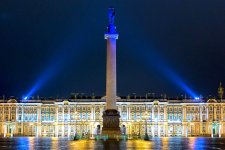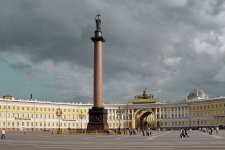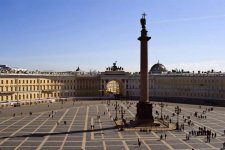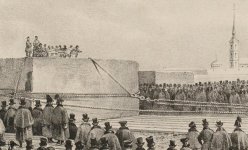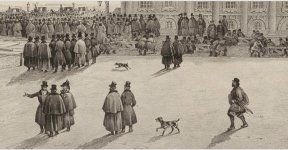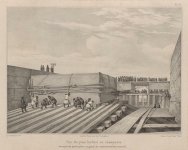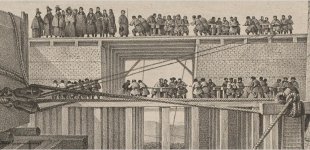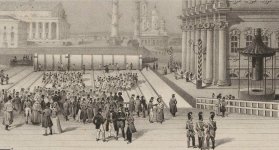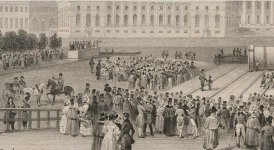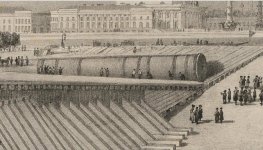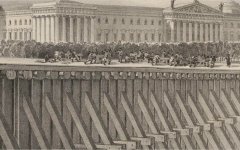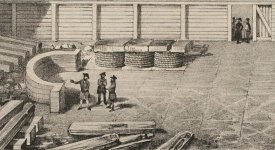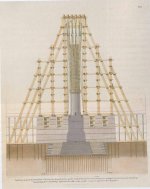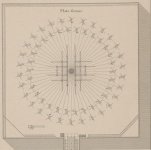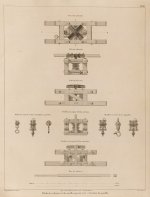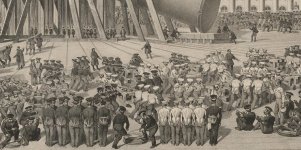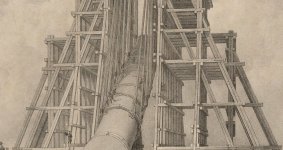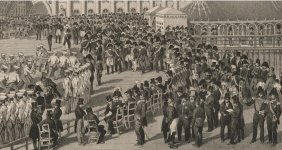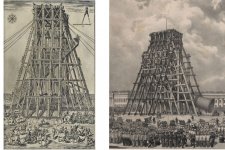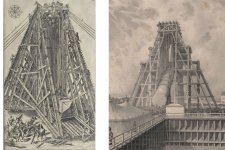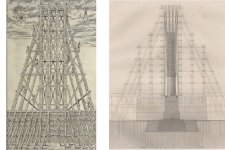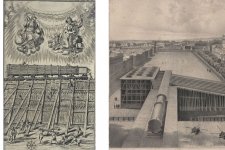What we have is one more historical inconsistency. Apparently, one of the most prominent architectural features defining the face of the Russian city of Saint Petersburg was not built when historians say it was. Additionally, may be it was not built by the reported individuals altogether. As a certain painting suggests, there was a structure in place of the column, and the column itself could be a remaining pillar of the older, possibly Tartarian, mega structure.
The Alexander Column
Weight: 661 tons

column delivery workers
The Alexander Column also known as Alexandrian Column, is the focal point of Palace Square in Saint Petersburg, Russia. The monument was raised after the 1812 Russian victory in the war with Napoleon's France. The column is named for Emperor Alexander I of Russia, who reigned from 1801–25.

The Alexander Column was designed by the French-born architect Auguste de Montferrand, built between 1830 and 1834 with Swiss-born architect Antonio Adamini, and unveiled on 30 August 1834. The monument is topped with a statue of an angel holding a cross. As a monolith that has been quarried, moved and erected it is the heaviest recorded. The statue of the angel was designed by the Russian sculptor Boris Orlovsky.
Official story: The face of the angel bears great similarity to the face of Emperor Alexander I. Sure it does, lol.
Prince Grigory Gagarin was a Russian painter, Major General and administrator. He was born in Saint Petersburg to the noble Rurikid princely Gagarin family. His father, Prince Grigory Ivanovich Gagarin, was a Russian diplomat in France and later the ambassador to Italy. Thus until the age 13 the boy was with his family in Paris and Rome. Grigory did not receive a formal artistic education, but took private lessons from the famous Russian painter Karl Briullov who at that time lived in Italy.
In 1832 he returned to Saint Petersburg, became acquainted with Alexander Pushkin and illustrated his works The Queen of Spades and The Tale of Tsar Saltan.
In 1858 Gagarin received the military rank of Major General. In 1859 he became the Vice President of the Imperial Academy of Arts, and he remained there until 1872. Some sources list him as the President of the Academy, probably considering the Grand Duchess to be only a formal head of the institution. As the Vice President of the Academy Gagarin supported the "Byzantine style" (Russian Revival). He built the "Museum of Early Christian Art" at the Academy.
Here is where Prince Gagarin, and that German Encyclopedia come into play.
#1Sometime between 1832 and 1834 (allegedly of course), Mr. Gagarin completed the below painting titled "Alexander Column in scaffolds".

As we can see, one of the few paintings not directly related to documenting the raising process, demonstrates a totally different picture. The future Alexander Column is depicted as a corner pillar of some huge destroyed structure. We could definitely speculate as to why we have a painting like this. The reality is... we will never find out.
Somehow, in 1830, two years before the column was officially raised, page 183 of the 12th volume of Bertuch's Bilderbuch demonstrates the Alexander Column being fully erect, with no signs of construction.

If our German readers could assist with the translation of the below, it would be highly appreciated.

Today, the top of the column is crowned by an Angel with a Cross. According to the official version, there was nothing there before the Angel was installed.

Whoever is versed in the denomination differences could explain to us the difference between Patriarchal and Latin crosses. Also, how come we have anything but the Russian Orthodox cross in the middle of the Russian city?
Below are a few additional depictions of the Alexander Column, at a time, or in a shape it never officially existed in.

Sources:
KD: It appears, that once again we have a very well documented historical cover up of the real events. In this case it could be an introduction of the older structure into a new system. I have no clue as to the time frames of the actual events here, but it appears that the pre-existing "Tartarian" Column could have been fixed up to look nice, and to display what was politically convenient at the time.
Besides, it does appears that 1830s Montferrand stole drawings idea from 1586 Domenico Fontana. It's either that, or 250 years yielded no technological progress.
The Alexander Column
Weight: 661 tons
column delivery workers
The Alexander Column was designed by the French-born architect Auguste de Montferrand, built between 1830 and 1834 with Swiss-born architect Antonio Adamini, and unveiled on 30 August 1834. The monument is topped with a statue of an angel holding a cross. As a monolith that has been quarried, moved and erected it is the heaviest recorded. The statue of the angel was designed by the Russian sculptor Boris Orlovsky.
Official story: The face of the angel bears great similarity to the face of Emperor Alexander I. Sure it does, lol.
Prince Grigory Gagarin was a Russian painter, Major General and administrator. He was born in Saint Petersburg to the noble Rurikid princely Gagarin family. His father, Prince Grigory Ivanovich Gagarin, was a Russian diplomat in France and later the ambassador to Italy. Thus until the age 13 the boy was with his family in Paris and Rome. Grigory did not receive a formal artistic education, but took private lessons from the famous Russian painter Karl Briullov who at that time lived in Italy.
In 1832 he returned to Saint Petersburg, became acquainted with Alexander Pushkin and illustrated his works The Queen of Spades and The Tale of Tsar Saltan.
In 1858 Gagarin received the military rank of Major General. In 1859 he became the Vice President of the Imperial Academy of Arts, and he remained there until 1872. Some sources list him as the President of the Academy, probably considering the Grand Duchess to be only a formal head of the institution. As the Vice President of the Academy Gagarin supported the "Byzantine style" (Russian Revival). He built the "Museum of Early Christian Art" at the Academy.
Official Construction
Note: I used Google Translate services, hence definite weirdness of the text excerpts. The primary purpose of the below "construction" section, is to establish the official time table.
November and December 1829: At the first stage, work was carried out to create the foundation of the column and to extract a granite monolith in the Puterlaks quarry. Montferrand decided to make a foundation of granite blocks, laid in rows.For its construction, a 14 x 14 fathom pit was excavated (1 sazhen approximately equal to 2.13 meters) and a depth of 2 fathoms. The underground water was continuously inundating the pit, which was pumped out. At the bottom, piles and remains of stone foundations of the Peter the Great era were discovered. The piles were left, and the foundations had to be broken.
Construction of foundation and pedestal of the column
To compact the ground, 1250 piles were hammered (as in Montferrand, according to archival data, 1102 new piles were scored, as well as 99 old piles found during excavation). The length of each pile was about 6.5 meters, and the minimum thickness 26-27 cm. Sharp from below, they were hammered strictly vertically, at the same distance, about 70 cm from the center to the center. For pile drivers, copra were used with cast-iron women weighing 110 poods. Each koper served 12 workers and four horses. Driving was completed only when the pile's motion slowed down so much that after eight strokes of the heavy woman it retreated deeper by less than ¾ inches (~ 3 cm). As a result of the work carried out, the land acquired high strength. Montferrand wrote that her "even a crowbar was difficult to pick."
October 1830: On this pile foundation a pillow of large blocks of granite was laid, and over it - another 12 granite rows. Two rows of blocks directly under the pedestal of the column are connected by iron staples and are covered with lead to protect against moisture penetration. On all sides, a granite foundation was laid with masonry made of fragments of granite and old marble, rammed and fastened with an astringent mortar. In late October 1830, the foundation was completed.
October 20, 1831: Simultaneously with foundation, a monolith was produced in Pjuterlaks to make columns and stones for its foot. The contract for these works was concluded with the owner of the quarry "merchant's son" Vasily Abramovich Yakovlev. According to the plan of Montferrand, the lower part of the monument consisted of a pedestal, its foot - a socle (subasement), as well as a plinth (stage) and steps. Thanks to this, the overall height increased, and the column looked more elegant than the columns of Trajan in Rome and Napoleon in Paris.
Originally, Montferrand planned to make a plinth of granite mined in Serdobol (now Sortavala), believing that "his gentle bluish tone makes a good contrast with the dark color of the column." However, it was impossible to obtain a stone of the required value, and it was decided to make the base also from the rapakivi. The first block, extracted by Yakovlev, Montferrand did not accept because of the inconsistency of its size specified in the contract. Yakovlev sent several hundred workers to find a new suitable rock. The necessary block was found five miles from the Puterlaks, in the locality Letzarma (Letzarma). Then 500 stonemasons separated the monolith and polished it in accordance with the specified dimensions. October 20, 1831 "after three months of incredible effort", it, together with other blocks, was loaded onto a barge of a special design, specially built to transport the granite blocks of the pedestal from the quarry to Petersburg. The mass of the stone was more than 400 tons, and the total mass of the blocks, which the barge, towed by two steamships, transported for this flight - almost 700 tons.
Arrival of ships with stone blocks to St. PetersburgNovember 5, 1831: In the presence of the Commission and with a large crowd of people" the stone of the socle was unloaded from the ship to the Palace embankment.

February 3, 1832: After that, the stone with the help of nine cablewalks was lifted along the inclined ramp about four meters high. On February 3, 1832, he was overturned, turned over onto a pile of sand. Sand - to soften the blow. But still the blow was so strong that "the soil of the square of the Winter Palace hesitated." This event was attended by Nicholas I, Alexandra Feodorovna and others. Taking out the sand, which was so compacted that it had to be cut by picks, the stone was lowered onto the skating rinks and sent to the center of the granite platform of the basement.
The dictionary of Brockhaus and Efron says: To solve this difficult problem, Montferrand applied the following witty method: the monolith was dragged on rollers along an inclined plane to a platform built near the basement, and then piled it onto a pile of sand piled under the platform; The concussion of the earth was so strong that passers-by felt like an underground blow on the square. Then they brought up the supports, raked out the sand and laid the skating rinks; when this operation was over, the pods were knocked off, and the stone sat on the skating rinks, on which it rolled onto the foundation. But this was not the end: it was necessary to remove the rollers and properly install this colossal monolith. With the help of ropes, blocks and nine cableways (a special type of gate), he was lifted three feet, took out the rollers and then planted on the foundation, pouring a layer of slippery and very peculiar in composition.
For precise installation it was required with the help of the gate several times to turn the stone. Montferrand, foreseeing similar work, added a part of soap to the astringent solution. Therefore, the stone slid quite easily. Since the work was carried out at 10-15 degree frost, vodka was added to the solution.Turned the stone with just two cables.
The plan and section of the ramp for the installation of a plinth with a mass of 410 tons and two more granite blocks. Around the ramp, brick walls with a height of approximately 6 m and a thickness of more than 2 m were erected.
Monolith for the column began to be cut down in the summer of 1830. For this, the contractor employed from three hundred to four hundred people. During the course of work, Montferrand's assistant, the master of stone business E. Pascal, and the commander of the Friedrichsgam engineering team, Lieutenant Colonel Großlaub, were on hand. Montferrand himself came twice. Works stopped only in winter during severe frosts and blizzards. To protect the monolith from damage when separated from the rock, Montferrand ordered rounded its front edge. Due to this, a huge mass was to be gently slipped onto the "bed" from the chopped shrubbery, laid on top of the logs. The height of the "bed" was almost four meters. Then, from the outer ridge of the rock, after an incredibly hard work, a prism was separated, which in its size considerably exceeded the size of the future column, and then, with the help of huge levers and gates, moved from its place and piled on a soft and elastic litter of spruce branches.
Montferrand with the commission observed the process...
September 19, 1831: Montferrand writes that on September 19, 1831, "the rock, hesitating at its base, fell slowly and without a murmur into the bed prepared for it." In the autumn to transport a monolith was very dangerous. Therefore, right on the spot, they first began to fooling the monolith, and then to the hewing by special patterns. Work carried out for half a year 250 masons.

The drawing of the column shows patterns for shearing. The column is divided into 12 parts, for each part there was a template. In the drawing, templates No. 7 and No. 12:
April 1, 1832: In order not to damage the monolith when rolling from the place of extraction to the pier (which is more than 100 meters), on the rounded monolith left five broad belts of a larger diameter than the column itself.
On the map, in red, it's indicated where the column and the road to the pier were.
After that, with the help of gates, they began to roll the column to the dock for loading. It took 15 days to get to the pier by the arranged road. To clear the way, the contractor received the necessary amount of gunpowder in the Friedrichsgama garrison. The road was carefully leveled with rubble, and then the log flooring was laid over it. The quay and the mooring ("terraces") located opposite her built Yakovlev to his own account. He also had to build a raft with iron ladles to deepen the channel more than half a meter, since there was a danger that, taking such a cargo, the ship would sit on the ground.
To transport the column ship engineer Colonel Glasin (or Lieutenant Colonel KA Glazyrin?) Built a special vessel that could raise 65,000 poods. The vessel was built by Gromov.
June 19, 1832: Before the column was loaded into Puterlaks, Montferrand arrived. With him, he took a draftsman, who was supposed to capture what was happening for the album. Loading took place on June 19, 1832 in the presence of the chairman of the Commission for the construction of Count Julia Pompeyevich Litta.
The column collapsed on the edge of the ship, but did not fall into the water.
July 1-12, 1832: The situation was saved by Yu.P. Litta. He summoned from Friedrichsgam 600 soldiers and employees of the engineering team. "These brave soldiers, along with gentlemen officers, ran, through the mountains, arrived in less than four hours." Just marathon runners some! How did they manage to run almost forty kilometers so quickly. Perhaps Montferrand was very nervous, so the time for him contracted.
Together with the workers of Yakovlev for 48 (!) Hours of continuous work, they managed to load the monolith on board the "St. Nicholas".
The transition lasted four days, on July 1, 1832, the boat moored to the pier, which was located between the Winter and Admiralty.
The Winter Palace and the Admiralty had elevations for spectators. On the afternoon of July 12, the convoy was overloaded to shore using 20 cable cars.The whole operation lasted only 10 (ten!) Minutes. 640 workers, 26 foremen and two sailors took part in the unloading.
To avoid overturning "St. Nicholas" when reloading the column to the pier, from the Neva side, the beams, over which the monolith was rolled, were fixed on a heavily loaded ship, which acted as a counterweight, to a bot.
Moving the column to the embankment near the Winter Palace.
After that, the monolith was to be delivered to the place of installation on a pedestal. To this end, 600 carpenters made a 30.5 m wide road covered with thick boards. The road led from the pier along the Winter Palace to Dvortsovaya. Approximately in the middle of the distance, it turned into an inclined plane. On this plane, the column rose to a height of 10.5 m - to the level of the top of the pedestal - it turned out to be parallel to the facade of the Winter Palace. From here (perpendicularly) to the installation site was a high platform, completed by a platform. The distance from the pier to the platform was more than 250 m. Using gates and blocks, it was overcome in nine days. On the platform, the column moved on a giant sled (length> 25 m, width = 3.5 m), built of logs with a diameter of 0.5 m. Sleds pulled for ropes and moved along birch rinks.
Column, ready for lifting, rests on the skating rinks on a horizontal platform, located at right angles to the ramp, parallel to the southern facade of the palace.
August 30, 1832: The raising of the column was carried out with the help of built wooden scaffolding. The column had to be installed with a jeweler's precision to prevent even the slightest deviation from the vertical and from the center of the pedestal. To do this, the column had to be lifted with the help of ropes wound under five belts left on its trunk, then for some time to hold it suspended - so that the fluctuations ceased, and only after that it should be lowered.
Raising of the column
In the creation of scaffolding A. Adamini participated, who before that was engaged in the installation of the columns of the portico of St. Isaac's Cathedral. The height of the scaffolding reached 47 m, they were made of pine beams and fastened with metal bolts. Vertical racks consisted of four fastened bars, cross-section 45x45 cm. At the top, ten pillars were connected by five farms, on which the blocks of blocks - pulley blocks were suspended. On the 12 pillars, the reverse rotation blocks were reinforced. On each of the four sides of the forest were strengthened by struts in the form of an isosceles triangle. The struts were installed on the ground and were driven under them by temporary piles. Scaffolding was installed on a wooden square platform with a side dimension of 37 m (an area of 16235 square meters). This platform was placed on temporary walls 10 m high that surrounded the pedestal and were built of buta and bricks.
August 30, 1832: The rise of the column was scheduled for August 30, 1832, the day of the namesake of Alexander I. Two days before this event, a rehearsal was held of the column lifting for testing the strength of scaffolding and mechanisms, as well as for working out concerted actions of hundreds of people. The column was raised six meters from the wooden flooring and left to hang on the ropes for one hour. Everything went well. The day after the rehearsal, Nicholas I personally inspected the monument and preparations for installation and encouraged all the lower ranks of the guards units with money and wine.
It took only 100 minutes to rais the column.
The next day they began to dismantle the wooden structures: the road, the inclined platform, the scaffolding. From the scaffolding left only four risers, near which the stairs were built. Much longer dismantled the stone walls, which served as the basis for the scaffolding.
From the column, the belts were strapped, which were left on the monolith for rolling and lifting. At the same time, more than 200 people polished the column, which was completed in a few months.
August 30, 1834: The rest of the works were completed without any difficulties, and on August 30, 1834 the monument was solemnly consecrated in the presence of the Tsar, the royal family, the diplomatic corps, 100,000 Russian troops and representatives of the Prussian army.
TWO ISSUES
The official version states, that the column was raised on August 30, 1832, and all the "beautification" works were completed by August 30, 1834.Here is where Prince Gagarin, and that German Encyclopedia come into play.
#1
#2
The second issue contradicting the official version is the 12th volume of the German Encyclopedia for Children. It was published in 1830.Somehow, in 1830, two years before the column was officially raised, page 183 of the 12th volume of Bertuch's Bilderbuch demonstrates the Alexander Column being fully erect, with no signs of construction.
Below are a few additional depictions of the Alexander Column, at a time, or in a shape it never officially existed in.
Painting Arch of the General Staff (St. Petersburg), VS Sadovnikov, 1830

Alexander Column in St. Petersburg. Engraving. 1835
What's this?


And to top this topic off, apparently the column was not made using a single piece of granite. It looks like it consists of multiple parts covered in polymer granite plaster thing.Alexander Column in St. Petersburg. Engraving. 1835
What's this?
- Alexander Column
- Grigory Gagarin
- Alexander Column. Paintings.
- Bertuch's Bilderbuch - Digitale Sammlungen
- Alexander Column - We see what we see
- Friedrich Justin Bertuch
- A secret structure on the site of the Alexander Column
KD: It appears, that once again we have a very well documented historical cover up of the real events. In this case it could be an introduction of the older structure into a new system. I have no clue as to the time frames of the actual events here, but it appears that the pre-existing "Tartarian" Column could have been fixed up to look nice, and to display what was politically convenient at the time.
Besides, it does appears that 1830s Montferrand stole drawings idea from 1586 Domenico Fontana. It's either that, or 250 years yielded no technological progress.


